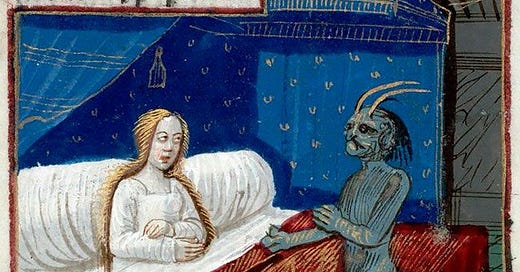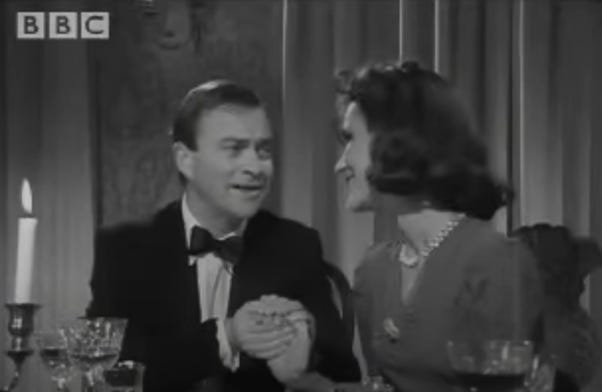Women, know your (magical) limits!
Why you shouldn’t teach women to read, a cautionary tale from medieval France
This is the story of the disastrous time when John of Morigny taught his little sister Bridget how to read.
Born in the late thirteenth century, John was a monk who wrote a book of prayers called The Flowers of Heavenly Teaching to which he later added a controversial ‘Book of Visions’ detailing his experiments with the magical occult. More specifically, John had been performing conjurations using the infamous grimoire Ars Notoria.
John was at first attracted to its ‘diverse colours,’ its ‘beautiful figures’ and, best of all, the fact that ‘it is a very short book.’
But he soon lamented judging Ars Notoria by its tempting cover:
“O cunning of the ancient serpent! O frenzy of the wicked lion, circling and seeking someone to devour! This is the craftiness of the ravening wolf! O false hypocrisy of the enemy, you who appear outwardly in sheep’s clothing, inwardly a ravening wolf!”
John began having visions. At first he believed they were coming from God, but as their imagery became more and more disturbing he realised that the shadowy figures stalking his sleep were emanating from another force altogether.
John eventually repented and escaped the clutches of the devil through the intercession of the Virgin Mary—
But not before he had done something very stupid.
“Now I, John, had a sister named Bridget who, when about fifteen years of age, at that point already marriageable, asked me spontaneously of her own will – I did not force her – daily and often to teach her to read. Considering her advanced age, I asserted that she would not now become very good at it. But she always affirmed the contrary.”
It’s tempting for a modern reader to side instantly with the plucky girl who longed to read despite growing up in a world that largely didn’t see the point of educating women. To the medieval mind, however, this was a potentially dangerous request, akin to a child asking to handle a blowtorch or drive a forklift truck.
John admits:
“I set her to the Ars Notoria, as boys learn who have learned nothing, and I showed the letters to her. And she learned so much – she who had never seen letters – that within the reckoning of half a year she was reading and writing everywhere; and what’s more, in the church before all the people sang an alleluia perfectly all by herself, without help, as graciously as an angel.”
So far, so edifying.
Yet John had broken a rule that most books of magic spelt out plainly, that the contents of a grimoire should only be shared with fellow scholars who had prepared themselves through lengthy study to handle the knowledge they contained.
Some grimoires insisted they should only be passed on when the moral character of a would-be magician had been proved for several years, and many explicitly mentioned women as a type of person too naturally stupid to make judicious use of their power.
Accordingly, Bridget started to suffer the effects of this exposure:
“In ecstasy while sleeping, she saw, or rather sensed, that a malign spirit came and stood near her in her bed, and the malign spirit pressed so hard upon the girl’s sides and back that she could neither speak nor cry out. He was always talking to her, threatening that he would kill her and torment her and not leave her in peace.”
It was only when the Virgin Mary appeared and told Bridget to cut off her hair as a penance that the violent attacks of the demon finally stopped. For the medieval reader the message was clear: knowledge could be dangerous and magical knowledge in particular should be kept well out of the reach of women.
Having read Ars Notoria a few years ago for my PhD, I have to admit being somewhat disappointed. I haven’t had a single nightmare and I’m no closer to hearing the Virgin Mary’s thoughts on what I ought to do next with my hair.
There is still a fun, illicit thrill when you call up a manuscript like that from an archive and turn the first page, but the truth is that, to an unbeliever, a lot of grimoires are pretty dull. If you don’t buy into their promises of magical shortcuts it’s like reading complicated recipes for dishes that can’t exist and you know you’ll never eat.
There are also strikingly mundane concerns showing through the elaborate descriptions of the esoteric — these are books promising male scholars the ability to appear more knowledgeable and more powerful than the rest, to be admired or feared, above all to be taken seriously — and their insecurities bleed into the detail of their spells. Their longings to fly, to find treasure and to see the future are endearingly far-fetched, their efforts to use demons to subdue and control have more sinister real-world implications. Above all, what you find in a grimoire is human desire.
I wonder whether the real Bridget did experience nightmares, or whether she, like me, found these fabled books a little underwhelming. Did she look behind the curtain and find that her brother was no great and powerful magician, just an ordinary man with ordinary fears and needs? Perhaps that’s why it was important that other people, particularly women, were deterred from looking too closely at those secret tomes—
Whoops! I’ve foolishly attempted a wild and dangerous opinion of my own. What I meant to say of course was that I don’t know anything about the secrets of the occult I’m afraid, but I do love little kittens, they’re so soft and furry.
Subscribe for more insights from my PhD on the history of belief in magic and its depiction in drama and elsewhere. I publish my ‘horror moments’ on Thursday mornings, and bonus content like this on Monday afternoons.







I think she just decided that she didn’t need demons to terrify her brother. She could do that by herself.
Jeez, more on long hair and uncontrollable women. Ive read pieces on Eves unbound hair, and a zillion Victorian takes on cutting women's hair when they had brain fever, and my mother's family cut her hair off because she was too skinny so obviously her hair was sapping her strength. She resisted the impulse with me but was sorely tempted. Our shared genetic anemia ran a distant second to hair for the cause of our wan appearance.